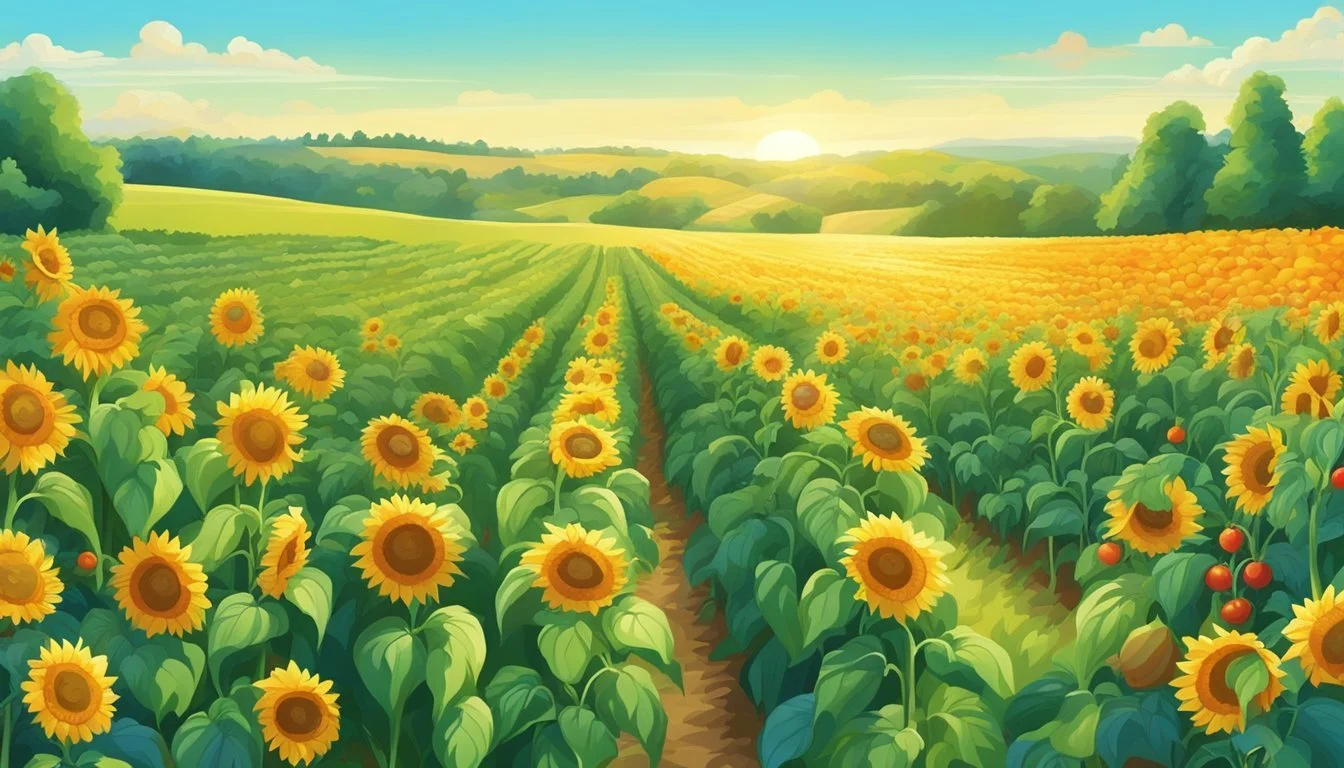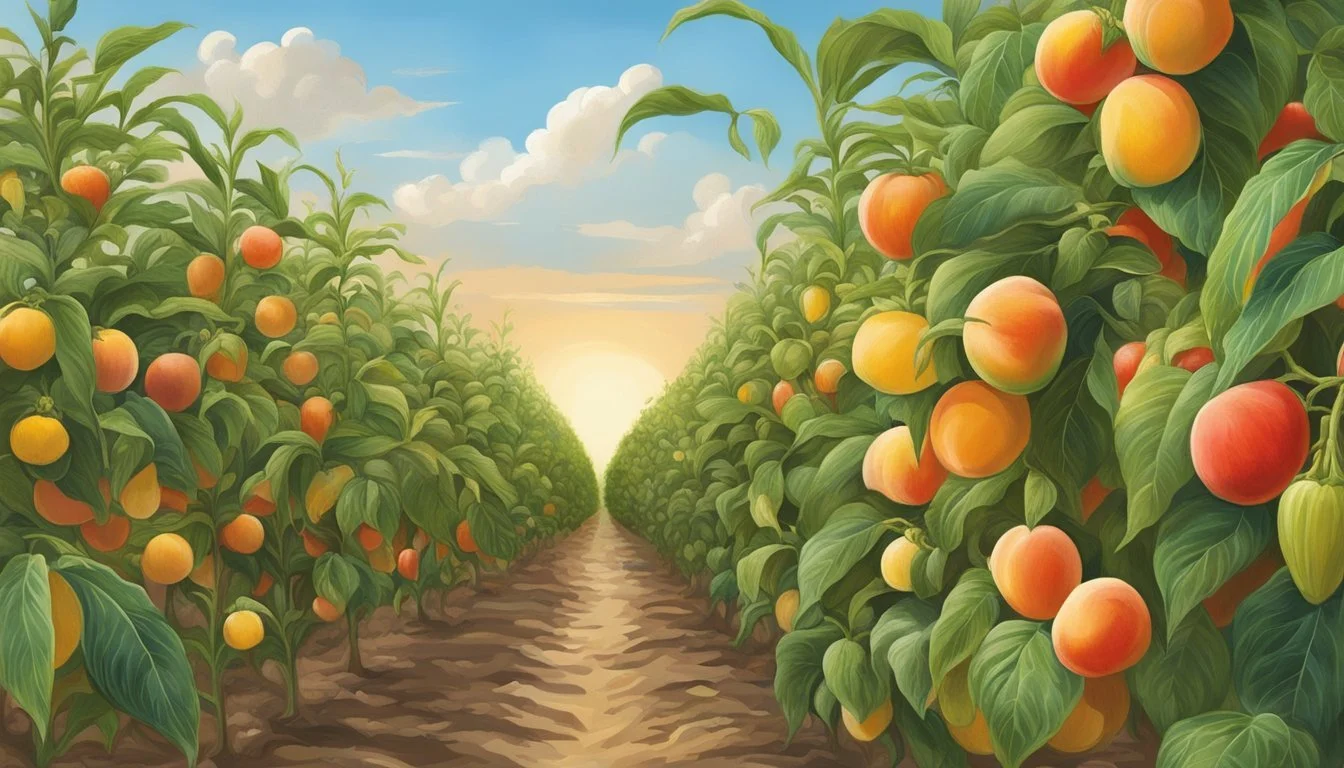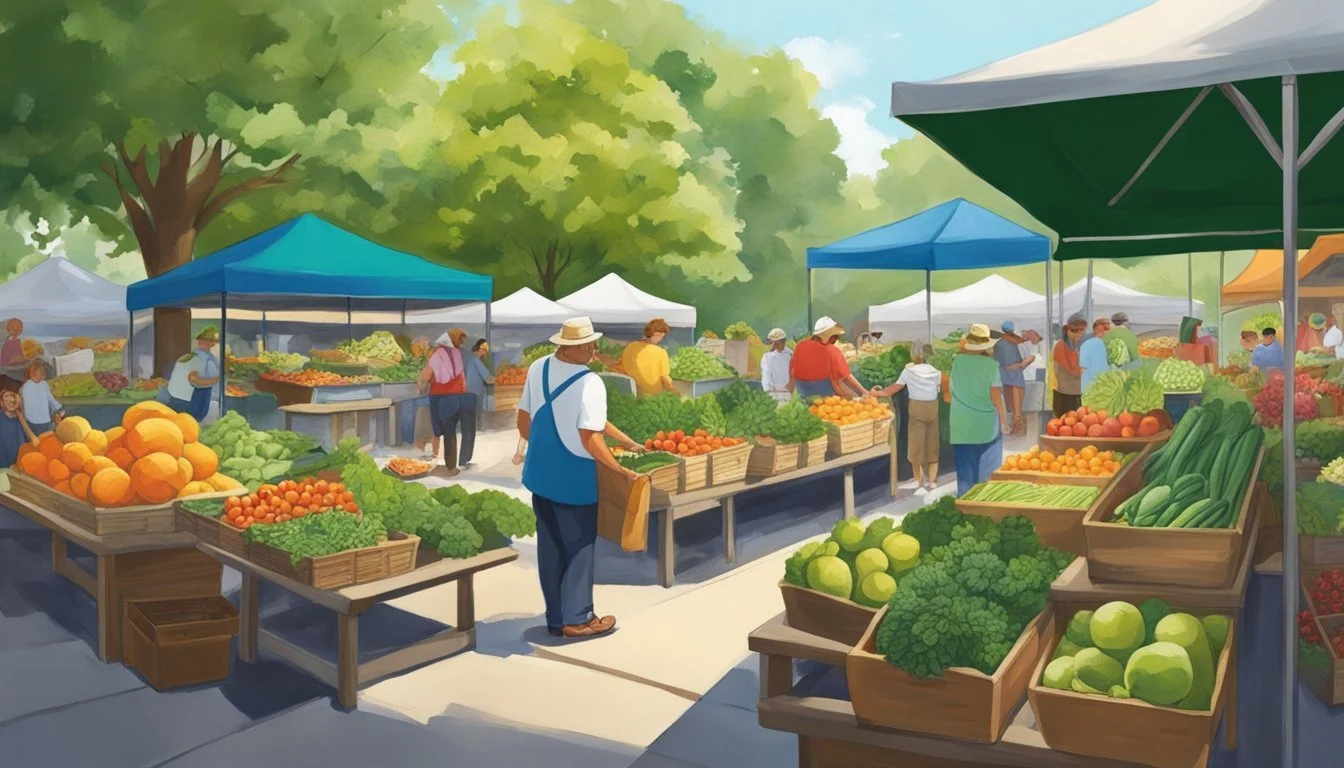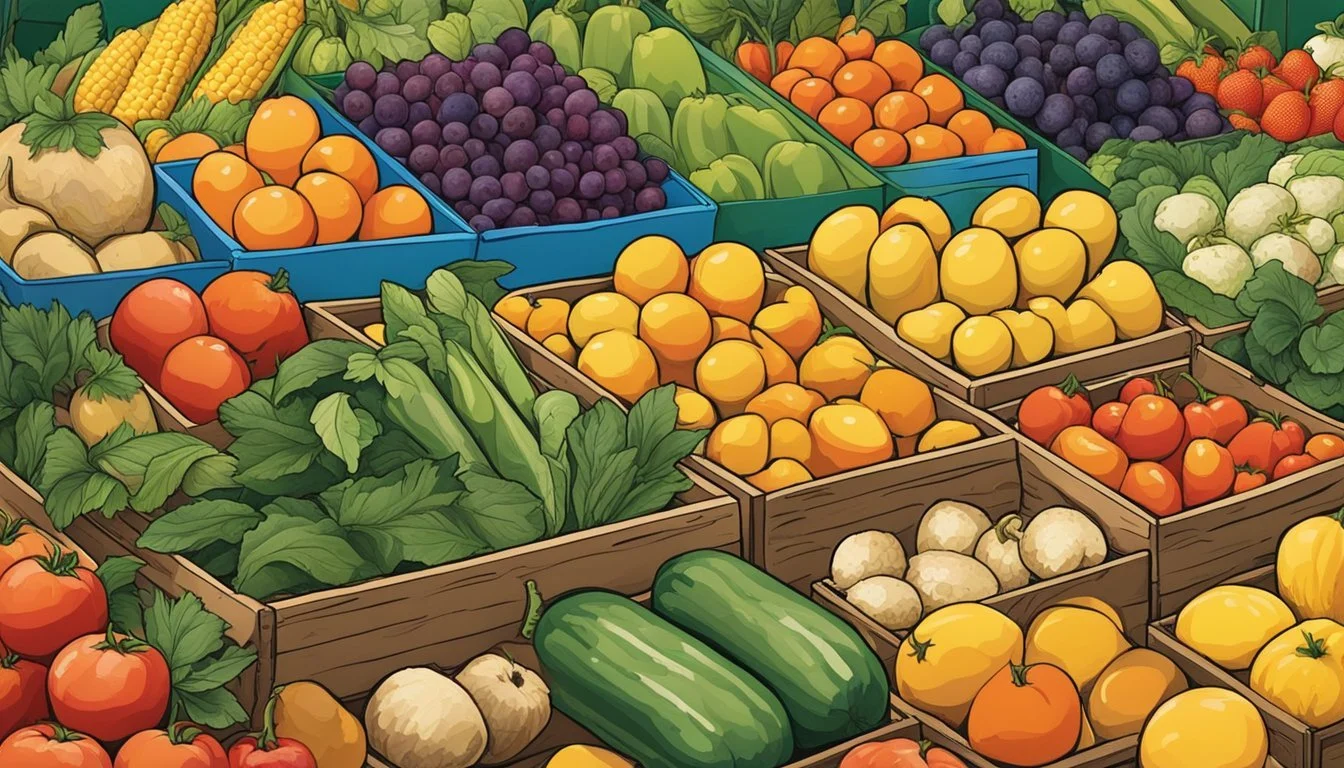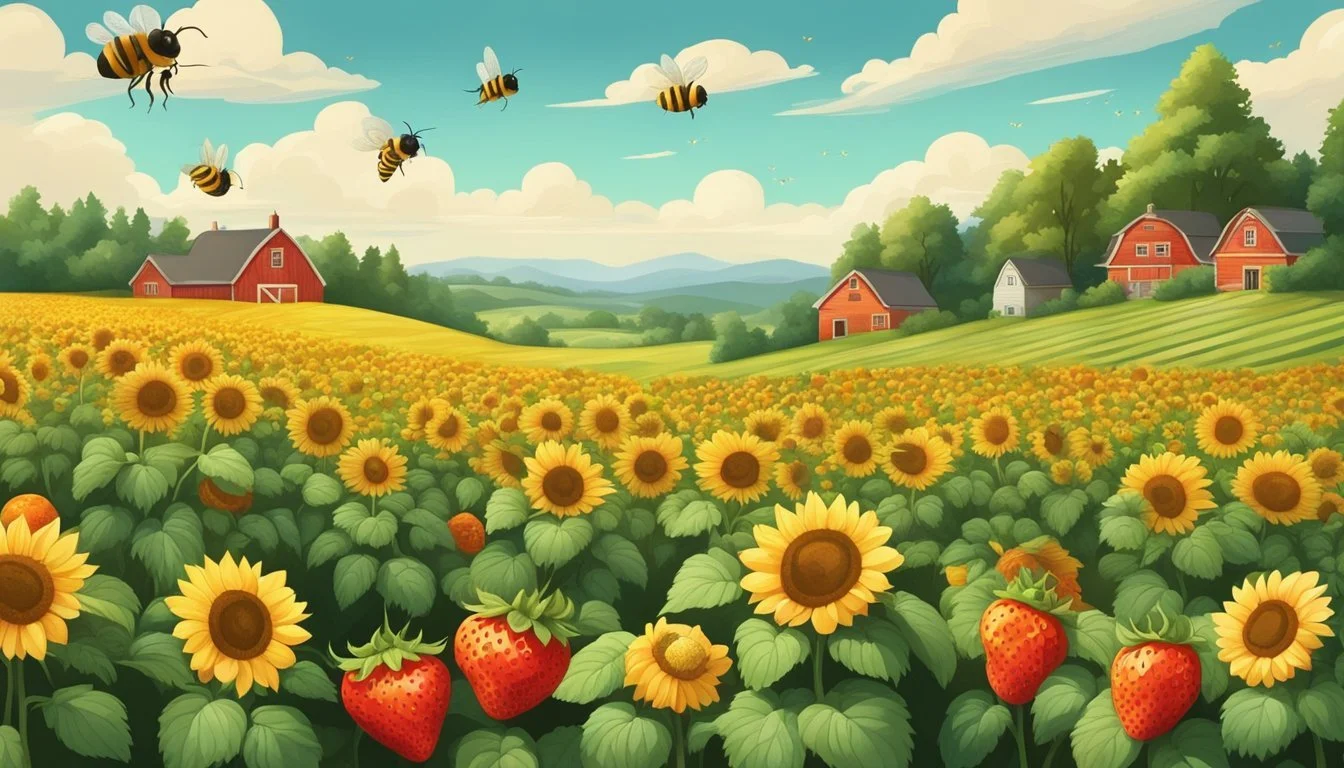Kansas Seasonal Fruit & Vegetables in July
Your Guide to Fresh Produce
This Article is Part of our Kansas Seasonal Fruit & Veg Calendar
July in Kansas marks a period of abundance for local gardens and farms, with a variety of fruits (What wine goes well with fruit?) and vegetables reaching their peak harvest. This is the time when the warm Midwestern temperatures confer an ideal growing condition for many crops. Among the highlights are the vibrant blueberries and the sweet, juicy cantaloupes (how long does cantaloupe last?)which are ripe for the picking. These fruits, along with the hearty selections of vegetables like broccoli (how long does broccoli last?)and carrots, offer a bounty for both the kitchen and the market.
Aside from these, Kansas fields are dotted with Brussels sprouts (how long do brussels sprouts last?) and cabbages. Their availability spans several months, but July is a particularly good time for these vegetables as they thrive in the summer warmth before the fall cooldown. Consumers seeking to integrate fresh, locally grown produce into their diets will find that Kansas in July offers a rich palette of flavors, textures, and nutrients.
The state's cultivation efforts extend to root vegetables as well, with carrots being readily available. They benefit from the season's weather to develop their crispness and sweet flavor, which can be enjoyed raw or cooked. This time of year, Kansans can take full advantage of the seasonal offerings, ensuring a fresh-from-the-garden experience on their plates.
Understanding Seasonality in Kansas
In Kansas, the season greatly influences what fruits and vegetables are available. Both the climate and the practice of seasonal eating impact local agriculture and consumer choices.
Importance of Seasonal Eating
Seasonal eating in Kansas supports local economies, reduces the carbon footprint associated with transporting food, and provides consumers with fresher produce. When residents choose to eat fruits and vegetables that are in season, they enjoy the peak of both flavor and nutritional value. This practice encourages diversity in diet and can lead to more creative meal planning as the variety of produce changes throughout the year.
Climate and Crop Seasons
Kansas experiences a climate that varies from subzero temperatures in winter to over 100 degrees Fahrenheit in summer, affecting the growth cycles of local produce.
Typical Growing Seasons in Kansas:
Spring: Late March to June
Summer: June to August
Fall: September to November
Winter: December to February
These seasons dictate the availability of different crops. For example, summer brings an abundance of fruits like peaches and vegetables such as tomatoes (What wine goes well with tomatoes?), which require warm weather to thrive. Kansas's climate and its seasonal changes directly inform the planting and harvesting schedules for farmers across the state.
Kansas's Seasonal Fruits in July
July in Kansas is a time of abundance for fruit lovers. This midsummer month offers a sweet and juicy selection, with local farms bustling with ripe fruits ready for the picking.
Summer Berries
In July, Kansas's fields are rich with a variety of berries. The blackberries and blueberries are particularly noteworthy for their deep, luscious flavors. These summer berries are perfect for fresh eating, desserts, or preserves.
Blackberries: Reach peak ripeness in July.
Blueberries: Available and at their best during this month.
Raspberries: While they have a shorter season, they can also be found ripe in early July.
Stone Fruits
The stone fruit season is in full swing in July, with cherries (how long do cherries last?), peaches, and plums dominating the scene. These fruits come with a delightful flesh that's both sweet and tart—an ideal treat on a hot summer day.
Cherries: Though their season is brief, cherries are usually still available in the early part of July.
Peaches: Succulent and fragrant, peaches are a highlight of the summer harvest.
Plums: Offer a variety of flavors ranging from sweet to tart, depending on the type.
Melons
Kansas heat cultivates a perfect environment for growing impressive melons, with watermelon being a quintessential summer fruit. They’re known for their refreshing and hydrating qualities.
Watermelon: Large, sweet, and refreshing, often enjoyed at summer gatherings and a staple July fruit.
Seasonal Vegetables to Enjoy
July in Kansas brings a bountiful harvest of vegetables to the table. Each category of vegetables comes with its own set of characteristics and optimal uses in the kitchen.
Leafy Greens
Leafy greens thrive in the warm yet mild Kansas summer. Kale and spinach are rich in nutrients and perfect for summer salads. One can find a variety of lettuce, which serves as a crisp, fresh base for any dish. These greens are typically harvested before they hit the peak heat of summer to maintain their cool crispness.
Kale
Spinach
Lettuce
Root Vegetables
Root vegetables such as carrots, onions, and radishes are also in season. They can be harvested throughout the month, ensuring a fresh supply for both raw and cooked dishes. Carrots, sweet and crunchy, are versatile for salads, roasting, or as a healthy snack. Onions add essential flavor to a multitude of recipes, while radishes provide a peppery bite to salads.
Carrots
Onions
Radishes
Nightshades and Cucurbits
The nightshade family offers summer favorites like tomatoes and peppers, both of which come in many varieties, colors, and flavors, ranging from sweet to hot. Eggplant (What wine goes well with eggplant?), another nightshade, is especially good when fresh and can be grilled, roasted, or blended into dips. The cucurbit family boasts summer staples such as cucumbers, zucchini, and squash. From zucchini bread to cucumber salads, these vegetables are as versatile as they are prolific.
Tomatoes
Peppers
Eggplant
Cucumbers
Zucchini
Squash
Herbs and Other Plant Foods
The month of July provides conducive conditions for a variety of plant foods to thrive in Kansas. The focus is not just on vegetables but also includes an array of herbs and fungi, each offering distinct flavors and culinary uses.
Aromatic Herbs
Basil grows exceptionally well during the warm summer months in Kansas. This herb prefers sunny locations and regular watering, making it ideal for July planting. Its leaves can be harvested throughout the growing season to add fresh, aromatic flavor to dishes.
Cilantro is another herb suited for the July climate. Although it tends to bolt in high heat, choosing a slow-bolting variety and planting it in partial shade can prolong its harvest. Cilantro is often used fresh and is a staple in salsa and other Mexican dishes.
Parsley, both curly and flat-leaf types, also thrives during this month. Parsley plants prefer moist, well-drained soil and can be harvested continuously by snipping the outer leaves, allowing the plant to keep producing.
Alliums and Mushrooms
Green onions and leeks are part of the allium family and can be planted in July. They require full sun and well-draining soil. Green onions have a quick turnaround and can be used in a variety of culinary dishes for their mild onion flavor.
Leeks take longer to mature but can be planted now for a late fall or early winter harvest. They are hardy and can tolerate the cool temperatures that Kansas experiences later in the year.
Although not planted, mushrooms can also be foraged during this season. While it is a bit less common to cultivate mushrooms at home compared to other edibles mentioned, one can find them growing naturally in certain conditions or buy them from local markets. They enrich many dishes with their umami flavor and can be a great source of protein.
Nutritional Benefits of Seasonal Produce
Eating seasonal produce offers numerous health advantages. Seasonal fruits and vegetables picked at their peak ripeness are more likely to retain their full nutritional value. These nutrient-dense foods can bolster the immune system, reduce inflammation, and offer other health benefits.
For instance, in Kansas, July brings a bounty of fruits such as peaches, which are rich in vitamins A and C. Vegetables like tomatoes are also in abundance, providing high levels of antioxidants like lycopene. Below is a list of common produce available in July in Kansas and their health benefits:
Peaches: High in fiber, vitamins, and minerals; aids digestion and skin health.
Tomatoes: Contain antioxidants, vitamin C, and potassium; support heart health.
Consuming these ripe seasonal foods may also lead to improved flavor and palatability, encouraging a higher intake of beneficial nutrients. In addition, fresher produce usually means a lower time gap between harvest and consumption, which can result in lower nutrient degradation compared to produce that has been stored for long periods.
Moreover, individuals who opt for seasonal produce are often supporting local agriculture which typically involves less transportation and storage time, helping to reduce the environmental impact of their food choices.
Table: Key Nutrients in Seasonal July Produce in Kansas
Produce Nutrient Health Benefit Peaches Vitamin A, C Immune support, skin health Tomatoes Lycopene Heart health, cancer prevention
Incorporating these foods into one's diet can contribute to a diverse and nutrient-rich intake, fostering overall health and well-being.
Preparing Seasonal Produce
July in Kansas offers a bounty of seasonal fruits and vegetables that can elevate the freshness and flavor of any meal. Knowing how to store and preserve this produce, along with incorporating it into simple and healthy recipes, can help individuals make the most of their summer harvest.
Storage and Preservation Tips
Asparagus (What wine goes well with asparagus?): They should be stored in the refrigerator with the cut ends wrapped in a damp paper towel. For preserving, asparagus can be blanched and frozen, or pickled.
Beets (how long do beets last?): Store beets in a plastic bag in the crisper drawer of the refrigerator. To preserve, one can pickle beets or slice and freeze them after blanching.
Blackberries and Blueberries: These berries should be kept in the refrigerator and can be frozen on a baking sheet before transferring to a freezer bag. For a long-lasting treat, berries can be made into jam or jelly.
Tomatoes: Keep tomatoes at room temperature until ripe and then move to the refrigerator. For preservation, canning tomatoes as sauces or whole is an option, and drying or freezing keeps them usable for months.
Broccoli and Brussels Sprouts: These vegetables last longer when stored in a humid part of the refrigerator. They can also be blanched and frozen.
Cabbage: It keeps well in the crisper drawer of the refrigerator. Cabbage can also be fermented to make sauerkraut (how long does sauerkraut last?) or kimchi (how long does kimchi last?).
Cantaloupes: Store at room temperature until ripe, then refrigerate. Cantaloupes can be cubed and frozen or made into a puree for sorbets.
Simple and Healthy Recipes
Salad: A fresh Kansas summer salad can include sliced tomatoes, blackberries, and blueberries topped with basil leaves. Drizzle with a vinaigrette for a light, refreshing dish.
Jam: Homemade blackberry or blueberry jam can be prepared with equal parts of fruit and sugar, pectin (how long does pectin last?), and a squeeze of lemon juice for a natural preservative.
Cooking Techniques: Roasting beets brings out their natural sweetness, and asparagus grills quickly for a smoky addition to meals. Steaming Brussels sprouts and broccoli helps preserve their nutrients.
Preservation Recipes: Pickled asparagus or beets can be made by combining vinegar, water, sugar, and spices, then boiling and sealing in jars. Tomato sauces can be cooked down and canned following safety guidelines.
Local Food Systems in Kansas
In Kansas, local food systems thrive during July, a peak season for fresh produce. Consumers can access a rich variety of fruits and vegetables through farmers markets and CSA programs, fostering a connection between growers and the community.
Farmers Markets and Farm Stands
Farmers Markets in Kansas offer a bounty of seasonal produce in July. Shoppers can expect to find:
Blueberries: Typically available from July into August.
Broccoli: Locally grown from June through October.
Cantaloupes: Peak season in August and September.
Kansas State University supports these local markets by providing expertise and research to enhance crop availability and diversity. Farm Stands, often located directly on farm property, provide an additional avenue for consumers to purchase fresh, Kansas-grown produce, ensuring they receive the freshest fruits and vegetables shortly after harvest.
Community Supported Agriculture (CSA)
Through Community Supported Agriculture (CSA), Kansas residents can subscribe to receive a share of the harvest from local farms. This model benefits both farmers, who receive early-season financial support, and consumers, who enjoy fresh produce throughout the season. CSA shares in July are abundant with a variety of items, including:
Tomatoes: Although technically a fruit, they're a staple in Kansas CSA boxes during the summer.
Carrots: Kansas carrots, stored from the fall, are remarkably sweet this time of year.
CSA programs often collaborate or are directly part of Kansas State University's initiatives, aiming to improve sustainable agriculture practices and promote the consumption of locally produced food.
Seasonal Eating Resources
Seeking information on seasonal fruits and vegetables available in Kansas during July can be efficiently managed through various resources. These resources help ensure consumers have access to the most fresh and nutrient-rich produce while supporting local farmers and sustainable agriculture practices.
Guides and Calendars
Guides specific to seasonal eating provide a monthly overview of what produce is available. Kansas residents can refer to:
Seasonal Produce Guides: These guides list fruits and vegetables that are in season each month. For July in Kansas, such guides would highlight the availability of blackberries, blueberries, broccoli, cabbage, carrots, cantaloupes, and more, bringing attention to the optimal time for consumption when freshness and nutritional value are at their peak.
Farmers' Market Calendars: Local farmers' markets often distribute calendars that give insights on the in-season produce that is expected to be available. Patrons can plan their visits based on these calendars to procure the freshest locally-grown produce.
Educational Materials from Local Institutions
Local institutions, such as Kansas State University, offer educational materials that emphasize the benefits of eating in season:
Extension Services: These local cooperative extension services often publish information on seasonal produce, along with tips on how to select and prepare them. They may also teach about the availability of produce, aiming to educate consumers on when and where to find the freshest fruits and vegetables.
Health Initiatives: Programs like Walk Kansas provide resources that explain the nutritional advantages of eating fresh, in-season produce. They often include produce availability charts which lay out the months certain fruits and vegetables are at their peak.
By utilizing these guides and educational materials, consumers in Kansas can make informed decisions and enjoy the abundance of fresh produce during the month of July.


